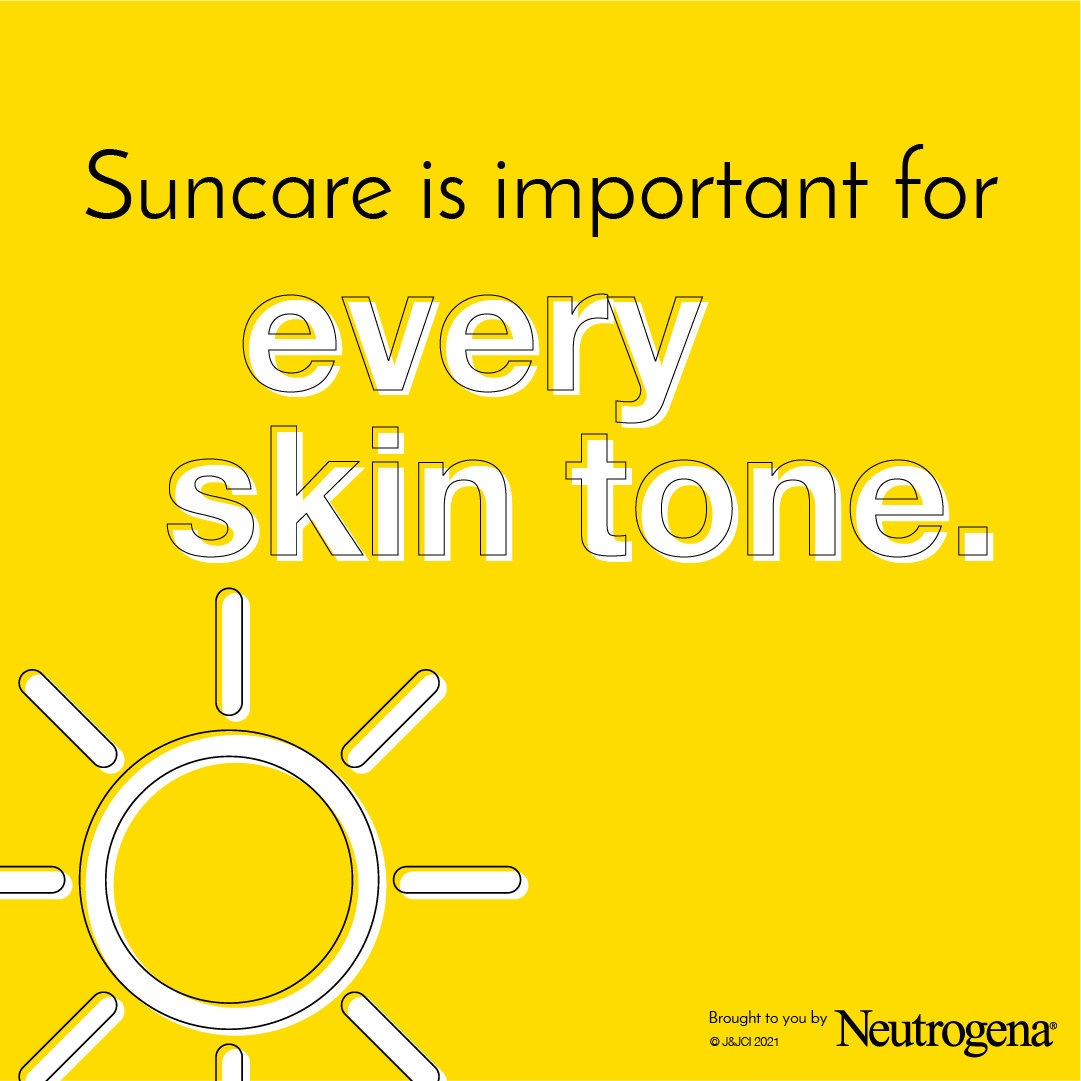Suncare is important for every skin tone.
The risk of sunburn and skin cancer correlate with skin type – not ethnicity.1
Ethnicity does not confer skin type.
Our population is changing rapidly, and within the next few decades minority populations will become the majority.1,2
African Americans, Asians, Hispanics, Middle Easterners, Asian Pacific Islanders, Native Americans, or individuals of any ethnicity can have lighter skin tones (Fitzpatrick skin phototypes (< or = to III) or sun sensitivity and live with the false notion that they are immune to skin cancer, when in reality, they may be at a comparable risk to Caucasians.1
All ethnicities include sun sensitive individuals.3
These individuals, who often have lighter skin tones regardless of race or ethnicity, have a higher incidence of sunburn.
Unprotected UV exposure causes DNA changes in the skin that can lead to premature aging.4
Hyperpigmentation and uneven skin tone are common concerns in darker skin tones. Sunscreen use can help prevent UV-induced skin discolorations.5
Poor engagement in sun protection behaviors could be reflective of lower awareness.6
-
- 63% of African Americans have never used sunscreens.7
- Those who protected their skin did so to avoid exacerbating existing skin conditions (e.g., vitiligo, melasma, eczema), sunburn-related discomfort, or to stay cooler.6
- Many protected their skin to prevent further “skin darkening” versus reducing skin cancer risk.6
Skin cancer affects people of all colors, races and ethnicities:8
-
- 2-4% of all cancers in Asians
- 4-5% in Hispanics
- 1-2% in Black people
While skin cancer is less common in people of color, the outcomes can be much worse.8
-
- 25% of melanoma cases in Black patients are diagnosed in later stages when the cancer has spread to nearby lymph nodes.9
- About 50% of basal cell carcinomas (BCCs) are pigmented – making them easier to miss.8
- Black patients have an average 5-year melanoma survival rate of only 67% vs 92% for whites.9
Outcomes can be improved through early detection, awareness and education.
While skin cancer is typically on sun-exposed areas, people with skin of color can be prone to skin cancer in areas that are less exposed to the sun, like the palms of the hands, the soles of the feet, the groin, inside of the mouth and under the nails.9
-
- In addition to preventing sunburn, sun protection is important for helping to prevent sun-induced hyperpigmentation and skin tone issues.
- The knowledge that UV radiation accelerates the signs of skin aging (dark spots, dryness, fine lines and dullness) helps patients see the value of sun protection.
- Stress the importance of monthly self-examinations and a full-body examination by a dermatologist once a year – or anytime they see a new or changing growth or mole, or a sore that doesn’t heal.
To learn more about suncare for every skin tone, see the infographic below.

We encourage all healthcare practitioners to download, print and display this infographic in waiting areas and exam rooms, and share with patients.
For additional resources and products that can help you promote sun-safe behavior in your patients, visit NeutrogenaMD.com
Access to 2 recent JDD CME podcasts below:
Suncare for All: New Insights and Solutions for Protecting Patients of All Skin Tones
Understanding & Changing Patient Behavior
References:
-
- Battie C, Gohara M, Verschoore M, Roberts W. Skin cancer in skin of color: an update on current facts, trends, and misconceptions. J Drugs Dermatol. 2013;12(2):194-198.
- Colby SL, Ortman JM. Projections of the Size and Composition of the US Population: 2014 to 2060. Washington, DC: US Census Bureau; 2015.
- Holman D.M., Ding H., Guy G.P., Jr., Watson M., Hartman A.M., Perna F.M. Prevalence of sun protection use and sunburn and association of demographic and behaviorial characteristics with sunburn among US adults. JAMADermatol. 2018;154(5):561–568. (May 1).
- UV Radiation & Your Skin https://www.skincancer.org/risk-factors/uv-radiation/#:~:text=Unprotected%20exposure%20to%20UVA%20and,including%20cataracts%20and%20eyelid%20cancers. Accessed 8.17.21.
- HOW TO FADE DARK SPOTS IN SKIN OF COLOR. https://www.aad.org/public/everyday-care/skin-care-secrets/routine/fade-dark-spots. Accessed 8.17.21.
- Buchanan Lunsford N, Berktold J, Holman DM, Stein K, Prempeh A, Yerkes A. Skin cancer knowledge, awareness, beliefs and preventive behaviors among black and hispanic men and women. Prev Med Rep. 2018;12:203-209. Published 2018 Oct 6. doi:10.1016/j.pmedr.2018.09.017.
- Pichon LC, Corral I, Landrine H, Mayer JA, Norman GJ. Sun-protection behaviors among African Americans. Am J Prev Med. 2010;38(3):288-295. doi:10.1016/j.amepre.2009.10.041.
- Ask the Expert: Is There a Skin Cancer Crisis in People of Color?https://www.skincancer.org/blog/ask-the-expert-is-there-a-skin-cancer-crisis-in-people-of-color/ Accessed 8.17.21.
- Skin Cancer Facts & Statistics AAD https://www.aad.org/media/stats-skin-cancern Accessed 8.17.21.
Did you enjoy this article? Find more on sun protection here.
Brought to you by NeutrogenaMD.

